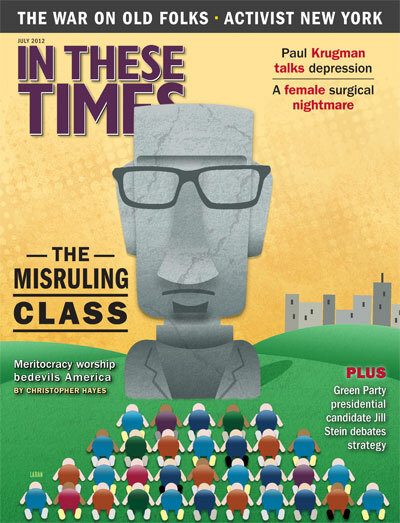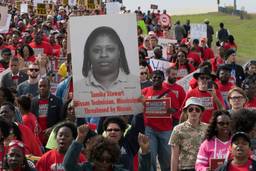
During the NATO protests in May, Mayor Rahm Emanuel, by massing police forces, contained the minority seeking a physical clash with authorities. The next day the front page of the Chicago Sun-Times trumpeted “The City That Worked.”
But for whom is the city working? That was the heart of the conflict in Emanuel’s backyard — actually, front lawn — on NATO weekend. On May 19, an energetic crowd of more than 800 descended on Emanuel’s house in the upper-middle-class neighborhood of Ravenswood to protest the city’s closing of six mental health clinics. Emanuel’s budget-balancing has disproportionately cut human services — despite meager savings for the city — while keeping costly aid and tax breaks for big businesses.
In May 2011, Emanuel took the reins of power from the city’s longest-serving mayor, Richard M. Daley. The new regime represents another turn in the evolution of Chicago politics but also, given Emanuel’s prominence and ties to both Presidents Clinton and Obama, a potential harbinger of Democratic urban policy nationally.
Journalists often focus on Emanuel’s style — tough, impatient, foul-mouthed, intimidating, ambitious. But Emanuel’s politics more significantly represent a triumph of corporatism in a city where the contest for working-class support has taken many forms.
Birthplace of modern liberalism
In the late 19th century, as Chicago’s economy boomed, workers organized unions, anarchist and socialist groups, and labor parties. After the 1886 Haymarket incident, business and government cracked down on these movements, but a new, independent labor political party emerged, again forcing the major parties to compete for labor support. Historian Richard Schneirov argues in Labor and Urban Politics: Class Conflict and the Origins of Modern Liberalism in Chicago, 1864-97 that the bargaining between Chicago’s vibrant 19th-century labor groups and the major parties birthed U.S. liberalism.
During the 20th century, two strains of “liberalism” competed for Chicago workers’ allegiance. One tendency, exemplified by Progressivism, the New Deal and the CIO unions, emphasized broadscale policy reforms. But it was the other strain, urban machine politics – emphasizing ethnic group allegiance to political patrons in return for favors — that dominated Chicago.
Both forms of liberalism, in quite different fashions, treated government as a positive force and addressed working class needs. But machine politics encouraged corruption, thwarted democracy, and mobilized citizens more through ethnicity than class. Unions split over loyalties to machine or class politics. At times, the more class-conscious reformers found middle-class allies who shared interest in good government reforms against machine politics, if not in redistributive policies.
From the 1960s on, race grew more important in the city’s politics, and the influence of class declined. After Mayor Richard J. Daley died in office in 1976, the machine slowly began to crumble. In 1983 Harold Washington took advantage of white machine disarray and black frustration (bolstered by progressive white and Latino allies) to win the mayoralty. A strong policy-oriented progressive, good government reformer, champion of labor and race leader, Washington, in his brief tenure — he, too, died in office, in 1987 — represented a high point of robust, working class-oriented liberalism.
Unlike his father, Richard M. Daley — elected in 1989 — did not like government, but he did admire big business. He privatized both services and assets (for example, leasing a toll road and the parking meters to private companies, and disastrously turning over recycling to Waste Management). He promoted charter schools and corporate-favored, anti-union education reforms. He turned tax-increment financing — originally designed to revive blighted areas — into a slush fund for big business. While shifting from the old, dwindling patronage army to conventional politics oriented toward fundraising and media, Daley still provided contracts to old friends (even mob-linked) and pin-stripe patronage to professionals. He exploited machine remnants (especially Latino) and survived innumerable scandals (and subsequent ethics reforms). Never fond of organized labor, Daley also turned away from the city’s working class, whatever the ethnicity, in favor of holding and attracting “middle class” families.
Triumph of the Corporate Dems
Emanuel pushes Richie Daley’s corporatization of local Democratic politics to a higher level. Elected with little grassroots mobilization (and from labor only the Teamsters’ endorsement), he relied heavily on national big-money contributors and a media-focused campaign. In governing style and in policymaking, he does not like democracy, the historian Rick Perlstein wrote recently in Rolling Stone. The two Daleys never liked democracy either, but in style they ruled more like banana republic strongmen. Richard M. Daley did not listen to community representatives, says DePaul political scientist Larry Bennett, “but Emanuel makes Daley look like an urban populist.” Emanuel does cleverly compromise on minor points to appear flexible and typically rationalizes every decision as a “tough choice” (oddly always made at the expense of the vulnerable or workers) that he makes “for the children.”
A man who quickly made a fortune in investment banking, Emanuel thinks and governs like a CEO. He focuses primarily on the needs of corporations and touts their new hiring, even though a Brookings Institution study ranks Chicago’s employment recovery from the recession as comparatively poor. Even more than his predecessors, he makes his top priority attracting the upper middle class with better schools for their kids and with, in Bennett’s words, “lifestyle liberalism.”
Emanuel shows his corporatist colors on many fronts. He plans to accelerate the public school system’s closure of troubled schools and opening of more charter schools, despite evidence that overall charter schools perform no better, and often worse, than regular schools. But he also has attacked the teachers union and tried to push changes — such as a longer school day with minimal pay increases — without bargaining or involving teachers in decision-making. Demoralized and angry teachers now seem likely to strike, which Emanuel may see as an opportunity to weaken the union.
Recently the City Council approved Emanuel’s Infrastructure Trust, a public-private vehicle controlled by a board of private sector investors and a token alderman appointed by the mayor. It will spend billions of dollars on as yet largely undefined infrastructure — one concrete plan is to install more energy-efficient technology in city buildings. The Trust provides no public input on planning and almost no accountability, even though the city never explained why it could not simply issue municipal bonds and do the work itself.
Emanuel’s budget makes egregious cuts in services for the working poor, even when they save little. Closing mental health clinics saves only $2 million, roughly 1 percent of the public health department budget. Emanuel never considered shifting surpluses from TIF funds to save those services, but recently pledged $29 million to help a giant developer build a new office tower.
Despite the second Daley’s extensive privatization, “corporate capital did not have its fingers in government like today,” argues AFSCME Council 31 Deputy Director Roberta Lynch. But after basking in early popularity and favorable press coverage as a reformer, Emanuel and his corporate-style governing are losing support. [Full disclosure: The author’s wife works for Illinois AFSCME.]According to a Chicago Tribune poll, barely half of all Chicagoans and only 44 percent of African-Americans support Emanuel, with his biggest support coming from whites, the affluent and men.
An alternative to Rahmboism is possible. It might focus on good public schools for all children, public infrastructure investment, broad public services, progressive taxes, more democracy (including participatory budgeting), and job creation through enhanced coordination and training among innovative institutions in advanced manufacturing, education and healthcare. But it may take a contemporary variant of the working class political challenges in late 19th-century Chicago to reverse Mayor Emanuel’s corporatization of Democratic urban politics.

I hope you found this article important. Before you leave, I want to ask you to consider supporting our work with a donation. In These Times needs readers like you to help sustain our mission. We don’t depend on—or want—corporate advertising or deep-pocketed billionaires to fund our journalism. We’re supported by you, the reader, so we can focus on covering the issues that matter most to the progressive movement without fear or compromise.
Our work isn’t hidden behind a paywall because of people like you who support our journalism. We want to keep it that way. If you value the work we do and the movements we cover, please consider donating to In These Times.
David Moberg, a former senior editor of In These Times, was on staff with the magazine from when it began publishing in 1976 until his passing in July 2022. Before joining In These Times, he completed his work for a Ph.D. in anthropology at the University of Chicago and worked for Newsweek. He received fellowships from the John D. and Catherine T. MacArthur Foundation and the Nation Institute for research on the new global economy.








